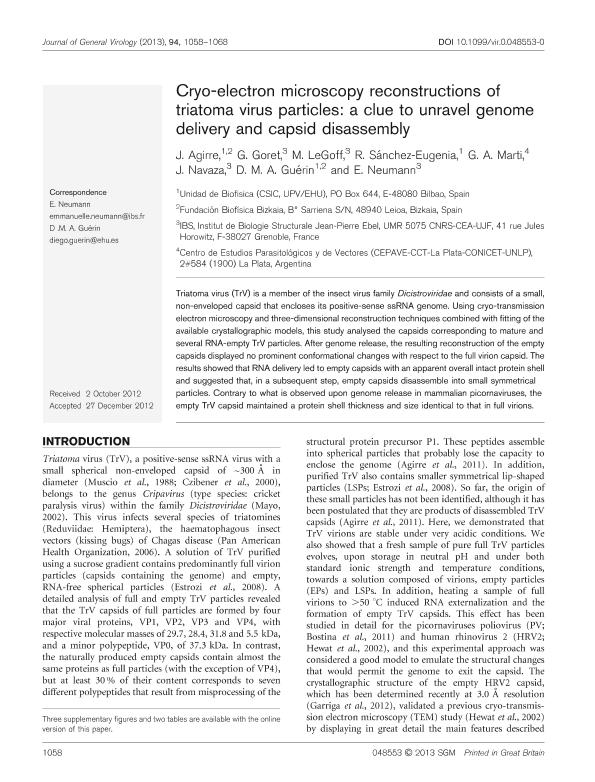Mostrar el registro sencillo del ítem
dc.contributor.author
Agirre, J.
dc.contributor.author
Goret, G.
dc.contributor.author
LeGoff, M.
dc.contributor.author
Sanchez Eugenia, R.
dc.contributor.author
Marti, Gerardo Anibal

dc.contributor.author
Navaza, J.
dc.contributor.author
Guerin, D. M. A.
dc.contributor.author
Neumann, E.
dc.date.available
2017-01-13T17:15:06Z
dc.date.issued
2013-03
dc.identifier.citation
Agirre, J.; Goret, G.; LeGoff, M.; Sanchez Eugenia, R.; Marti, Gerardo Anibal; et al.; Cryo-electron microscopy reconstructions of triatoma virus particles: a clue to unravel genome delivery and capsid disassembly; Society For General Microbiology; Journal Of General Virology; 94; 3-2013; 1058-1068
dc.identifier.issn
0022-1317
dc.identifier.uri
http://hdl.handle.net/11336/11283
dc.description.abstract
Triatoma virus (TrV), a positive-sense ssRNA virus with a small spherical non-enveloped capsid of ~300 Å in diameter ( Muscio et al., 1988 ; Czibener et al., 2000 ), belongs to the genus Cripavirus (type species: cricket paralysis virus) within the family Dicistroviridae ( Mayo, 2002 ). This virus infects several species of triatomines (Reduviidae: Hemiptera), the haematophagous insect vectors (kissing bugs) of Chagas disease ( Pan American Health Organization, 2006 ). A solution of TrV purified using a sucrose gradient contains predominantly full virion particles (capsids containing the genome) and empty, RNA-free spherical particles ( Estrozi et al., 2008 ). A detailed analysis of full and empty TrV particles revealed that the TrV capsids of full particles are formed by four major viral proteins, VP1, VP2, VP3 and VP4, with respective molecular masses of 29.7, 28.4, 31.8 and 5.5 kDa, and a minor polypeptide, VP0, of 37.3 kDa. In contrast, the naturally produced empty capsids contain almost the same proteins as full particles (with the exception of VP4), but at least 30 % of their content corresponds to seven different polypeptides that result from misprocessing of the structural protein precursor P1. These peptides assemble into spherical particles that probably lose the capacity to enclose the genome ( Agirre et al., 2011 ). In addition, purified TrV also contains smaller symmetrical lip-shaped particles (LSPs; Estrozi et al., 2008 ). So far, the origin of these small particles has not been identified, although it has been postulated that they are products of disassembled TrV capsids ( Agirre et al., 2011 ). Here, we demonstrated that TrV virions are stable under very acidic conditions. We also showed that a fresh sample of pure full TrV particles evolves, upon storage in neutral pH and under both standard ionic strength and temperature conditions, towards a solution composed of virions, empty particles (EPs) and LSPs. In addition, heating a sample of full virions to >50 °C induced RNA externalization and the formation of empty TrV capsids. This effect has been studied in detail for the picornaviruses poliovirus (PV; Bostina et al., 2011 ) and human rhinovirus 2 (HRV2; Hewat et al., 2002 ), and this experimental approach was considered a good model to emulate the structural changes that would permit the genome to exit the capsid. The crystallographic structure of the empty HRV2 capsid, which has been determined recently at 3.0 Å resolution ( Garriga et al., 2012 ), validated a previous cryo-transmission electron microscopy (TEM) study ( Hewat et al., 2002 ) by displaying in great detail the main features described formerly for this virus. These characteristics are as follows: (i) their structures display a mean expansion of ~4 %, (ii) there is a reduction in the thickness of the protein shell, and (iii) there are structural rearrangements of the open channels of the proteins traversing the capsid. In this work, we have reported cryo-TEM reconstructions of full particles, natural EPs (n-empty), EPs produced experimentally by heating virions (e-empty) and EPs that appeared after storing virions for a few days (s-empty). A numerical analysis of the different cryo-TEM reconstructions enabled us to score the similarities between the different particles. Docking the atomic model of the TrV capsid proteins into the cryo-TEM reconstructions allowed us to estimate that no major changes had occurred to the capsid following genome release. Our observations indicated that RNA release in TrV produces an empty shell very similar to the mature virion capsid. In addition, LSPs resulting from the disassembly of the capsid were clearly associated with genome release. In contrast to similar studies, none of the three salient characteristics of the empty picornavirus models summarized above were observed in the TrV empty-capsid reconstructions.
dc.format
application/pdf
dc.language.iso
eng
dc.publisher
Society For General Microbiology

dc.rights
info:eu-repo/semantics/openAccess
dc.rights.uri
https://creativecommons.org/licenses/by-nc-sa/2.5/ar/
dc.subject
Triatoma Virus
dc.subject
Dicistroviridae
dc.subject
Cryo-Transmission Electron Microscopy
dc.subject.classification
Virología

dc.subject.classification
Ciencias Biológicas

dc.subject.classification
CIENCIAS NATURALES Y EXACTAS

dc.title
Cryo-electron microscopy reconstructions of triatoma virus particles: a clue to unravel genome delivery and capsid disassembly
dc.type
info:eu-repo/semantics/article
dc.type
info:ar-repo/semantics/artículo
dc.type
info:eu-repo/semantics/publishedVersion
dc.date.updated
2016-11-24T19:26:12Z
dc.journal.volume
94
dc.journal.pagination
1058-1068
dc.journal.pais
Reino Unido

dc.journal.ciudad
London
dc.description.fil
Fil: Agirre, J.. Universidad del Pais Vasco; España. Fundación Biofísica Bizkaia; España
dc.description.fil
Fil: Goret, G.. Institut de Biologie Structurale Jean-Pierre Ebel; Francia
dc.description.fil
Fil: LeGoff, M.. Institut de Biologie Structurale Jean-Pierre Ebel; Francia
dc.description.fil
Fil: Sanchez Eugenia, R.. Universidad del Pais Vasco; España
dc.description.fil
Fil: Marti, Gerardo Anibal. Consejo Nacional de Investigaciones Científicas y Técnicas. Centro Científico Tecnológico la Plata. Centro de Estudios Parasitológicos y de Vectores (i); Argentina. Universidad Nacional de La Plata; Argentina
dc.description.fil
Fil: Navaza, J.. Institut de Biologie Structurale Jean-Pierre Ebel; Francia
dc.description.fil
Fil: Guerin, D. M. A.. Universidad del Pais Vasco; España. Fundación Biofísica Bizkaia; España
dc.description.fil
Fil: Neumann, E.. Institut de Biologie Structurale Jean-Pierre Ebel; Argentina
dc.journal.title
Journal Of General Virology

dc.relation.alternativeid
info:eu-repo/semantics/altIdentifier/url/http://jgv.microbiologyresearch.org/content/journal/jgv/10.1099/vir.0.048553-0#tab2
dc.relation.alternativeid
info:eu-repo/semantics/altIdentifier/doi/http://dx.doi.org/10.1099/vir.0.048553-0
Archivos asociados
